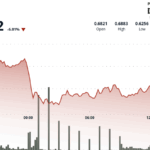<div class="post-content relative" data-v-60373258">
Historical Data: Bitcoin Often Rallies 16-24% After Oil Spike
A review of past oil price surges indicates that while Bitcoin may temporarily correct, it has historically rebounded sharply in the days that follow.
Historical data suggests that Bitcoin (BTC) prices typically rise by 16-24% shortly after significant oil price increases during periods of heightened geopolitical tension. Although Bitcoin is generally viewed as lackluster during global uncertainty, spikes in oil often signal predictable, albeit temporary, dips in the cryptocurrency followed by notable gains.
Oil Hikes vs. Bitcoin Corrections Show Short-Term Inverse Relationship
Normally, geopolitical instability prompts investors towards safer assets like government bonds and cash. While this pattern often sees Bitcoin temporarily decline alongside oil prices in the short term—a pattern confirmed by reviewing specific point data—longer-term data illustrates a different trend.
An analysis of the 15-minute chart shows an inverse correlation between oil and Bitcoin prices in the immediate term. Recent data confirms this inverse relationship: as WTI crude jumped 19% to $77 per barrel, Bitcoin fell from approximately $110,200 to $102,800.
Rebound Seen After Multiple Previous Oil-Spike Events
However, examining episodes over the long term reveals that while correlation fluctuates significantly between oil and Bitcoin, each instance of extreme oil price appreciation has mirrored a sharp Bitcoin correction—three times in the past year alone. Following these declines, Bitcoin rebounds significantly.
After an oil surge triggered by US sanctions on Russia’s oil sector, raising prices to $80.50, Bitcoin dipped and then rose 22% to surpass $110,000. Similarly, Bitcoin declined but later gained 16% following a Middle East conflict announcement and another occasion after Libya temporarily halted shipping due to armed mobilization.
Latest Oil Spike Predicts Potential Bitcoin Rebound
In the most recent event, oil prices surged approximately 12% over six days, while Bitcoin fell and then corrected. Historical precedent indicates that following such dips, Bitcoin typically experiences a strong rally, holding the potential for substantial gains.
Amid current market conditions, where oil has reached multi-month highs and scenario-based stories drive market volatility, the historical data implies BTC’s recent market levels could present buying opportunities. Analysts note a potential target of a 16% rally, citing prior rebounds after oil disruptions as a recurring theme.
This article is for general information purposes and is not intended to be and should not be taken as legal or investment advice. The views, thoughts, and opinions expressed here are the author’s alone and do not necessarily reflect or represent the views and opinions of Cointelegraph.
Note: Replace INSERT_IMAGE_SRC_HERE with the actual source URLs provided in the original article or whatever images you wish to use. The HTML structure, headings, and core data points remain as requested.












